features
A Research Building for Today—And Generations to Come
Providing scientists and engineers collaborative space to solve complex problems
 Image: Rendering by HGA
Image: Rendering by HGAWhen completed in 2026, Case Western Reserve's Interdisciplinary Science and Engineering Building (ISEB) will be the university's first new research structure in more than two decades—and the first on the Case Quad since 1994.
For President Eric W. Kaler, the ISEB will be another of several projects constructed during his service as a university president. During his tenure as president at the University of Minnesota, several new buildings opened and research funding grew by more than 35%.
Just before the fall semester began, President Kaler spoke to Think about the project.

CWRU President Eric W. Kaler
Everyone understands this is a critical need in order to accomplish several of our goals, including growing our research efforts and improving the quality of all that we do. I talk about the ISEB with almost everyone I meet, and I am pleased that so many people here in Cleveland, including business, civic, and community lead- ers as well as elected officials, are supportive of what we're doing. Likewise, when I meet with alumni around the country, they are happy to hear about this transformational new building.
Research increased significantly while you were at the University of Minnesota—were new and improved facilities part of that growth?Oh, absolutely. You've got to have space to do what you need to do. [Facilities] can be absolutely limiting in the amount and kind of grant support that an investigator can win.
How did you decide that your first research building would focus on both science and engineering?Most of the challenging problems facing us today need an interdisciplinary approach to their solution. Of course you can do interdisciplinary work in existing space, but here, where the needs are so strong across science, medicine and engineering, it makes sense for this space to be an interdisciplinary building. It will be a welcoming environment for many of our faculty whose work is truly interdisciplinary and will foster future collaborations.
How do you think about developing a building that will serve generations to come?About the only thing you know about the space needs for the future is that they will be different than they are now. So the building literally needs to be flexible, so movable walls, movable benches and movable utilities are all part of what we will see. We are working with excellent architects who are designing spaces that promote interdisciplinary collaboration for now and in the future.
This building will offer a much more welcoming façade to area residents—why is that important to you?Today the Case Quad's western side presents the back side of brick and stone buildings to the community, and there are no obvious entrances. Community engagement is one of our top priorities, and this project conveys that commitment in a tangible way. I really like the renderings of the building, and the façade facing MLK Jr. Drive will draw the community in with places to sit and reflect or to pleasantly walk through as they make their way onto and across campus. The building also will have a café that will be open to the public.
What happens to spaces that are vacated when some faculty relocate to the new building?There will be a cascade. There will be someone who moves into the ISEB, and that previous lab can be a major upgrade for somebody else. The idea is that we are improving lab space for as many of our faculty as possible.
How will you assess its success?Oh, that's easy: growth in research dollars, growth in number of graduate students, growth of publications and growth of reputation will all be markers of success.
How long after the ribbon-cutting would you expect to see signs of its impact?I'd expect to begin to see it in year two. We should see some new grant funding and the ability to attract new faculty early on.
An Unprecedented Investment in Research Facilities
Highlights of the Interdisciplinary Science and Engineering Building include:


Joy K. Ward
“As a new and welcoming gateway to our university, the ISEB will serve as a constant reminder that our research aims to positively impact lives in our community, our region and around the world.”
—Joy K. Ward, PhD, interim provost

Balakrishnan “Ragu” Ragu
“We know new breakthroughs are possible when people with different backgrounds and perspectives work together. We want to push the boundaries of knowledge, so we're changing how we're conducting research.”
—Venkataramanan “Ragu” Balakrishnan, PhD, the Charles H. Phipps Dean of the Case School of Engineering

Michael Oakes
“Science is a social process defined by interaction and empirical debate. The ISEB will help catalyze the university's problem- solving mission through discovery and translation.”
—Michael Oakes, PhD, senior vice president for research and technology management





